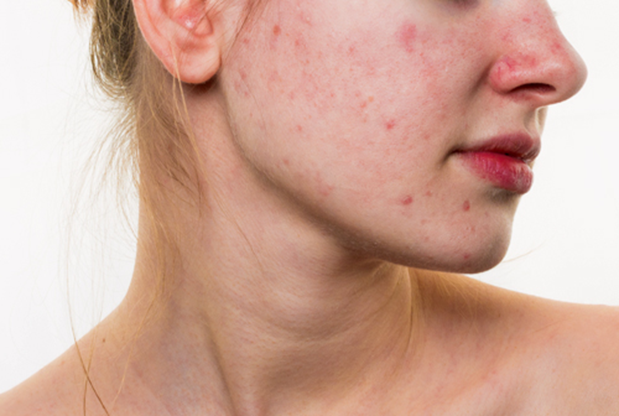Acne Scarring
Most acne scars are depressed scars caused by the underproduction of collagen when the original acne lesion or cyst is naturally repaired by the skin. There are essentially 3 types of depressed scars. Boxcar scars are round depressions with steep and well-defined borders. Ice pick scars are very narrow but deep scars that may even appear as a very large pore. Rolling scars are depressions in the skin without well-defined borders that are sloping. Hypertrophic and keloid acne scars are raised, firm scars that may grow larger than the original wound. Acne scarring may become more noticeable as we age secondary to the loss of volume in our face and collagen in our skin.
- Treatment: There are many options to treat acne scarring but the best option is to start with prevention. Prevention will include topical treatments and possibly oral medications. Once scarring has occurred it is more difficult to deal with. There are many options to include lasers like the Vivace Microneedling, Sciton Halo, Profractional or Erbium Laser, c02/Deep FX, Microneedling, and AGNES RF that will benefit many types of depressed or hypertrophic scars. Other options will include using soft tissue fillers such as Juvederm, Restylane or Bellafill to elevate the depressed scarring.
Large Pores
Pores are small openings in the skin that allow oil and sweat to come to the surface of the skin. Pores will become more prominent as we age. As we age our skin loses some of the collagen and elastin that supports the pore opening. As this happens, the pores may become more visible. Genetics can also play a role in pore size and men tend to have larger pores.
- Treatment: Vitamin A derivatives such as Retinols and tretinoin are beneficial in exfoliating the skin. Chemical peels vary in strength but when performed on a regular basis you will see an improvement in the size of your pores. Microdermabrasion has been shown to decrease the size of the pores but must be completed regularly to maintain results. The HALO laser by Sciton has been shown to decrease pore size in studies, along with BroadBand Light (BBL) which can also help with skin tone and texture.
Closed Comedones
Otherwise known as whiteheads or pimples are produced with an overproduction of oils in the skin which mixes with keratin to clog the pores. The oils and keratin collect under the skin and may mix with a bacterium called Propionibacterium. This can lead to significant redness and inflammation. Some may lead to large cysts or nodules.
- Treatment: The first choice is to prevent further acne from developing. Topical over-the-counter products such as the Epionce and Obagi acne systems can help prevent new pimples from developing. Topicals are also a mainstay for treatment including salicylic acid washes and retinoids such as tretinoin and retinols. Chemical peels, HydraFacials, and Extractions can help prevent and treat active acne. In select patients, laser and light-based treatments can be beneficial. The BBL (BroadBand Light) can help destroy the Propionibacterium that causes inflammation. Lasers can also be used to treat the issues left behind with acne such as pigmentation, redness and scarring.
- Our aestheticians at Lazaderm can help with extractions of the active acne. It is very important to not pick at acne as it will increase inflammation and may lead to scarring.
Open Comedones
These are otherwise known as blackheads. They are caused when there is an overproduction of sebum that combines with keratin. The pore is larger than normal and the keratin, when exposed to air, causes it to oxidize and it can turn dark or black in color. There is also some melanin in the keratin leading to the dark color.
- Treatment: Topical agents such as in the Epionce and Obagi Skincare systems are excellent first choices in treatment along with a salicylic acid wash. Chemical peels with extractions can be completed by one of our aestheticians. HydraFacials done consistently can also help prevent blackheads.
- Improper techniques of extraction can lead to scarring.
Milia
These are pearl-like white cysts located in the skin and are different from acne. These are small collections of keratin under the surface of the skin. Most commonly they are found on the face on the cheeks or around the eyes.
- Treatment: Popping milia does not work. Extractions by a trained Aesthetician are the best treatment. Some things may help prevent them from forming such as retinoids when used at home. HydraFacials or Chemical peels completed regularly may also help prevent milia from forming.
Sebaceous Hyperplasia
This is the enlargement of the oil gland secondary to trapped oils. This tends to be more prominent in middle-aged people. Sun exposure seems to play a role in the development of sebaceous hyperplasia. The lesions can appear as yellow or flesh-colored bumps on the skin and can look like basal cell carcinomas.
- Treatment: Once you start to develop sebaceous hyperplasia you will likely develop more. It is best to try and prevent new lesions from developing using retinoids such as tretinoin or retinols at home. Salicylic washes can also help prevent the oil glands from plugging. Another option for removing the lesions is a laser, such as the erbium laser. Dr. Hansen prefers to use electrocauterization with the Ellman Radiofrequency. The radiofrequency allows us to insert a very fine filament into the lesion to destroy the oil gland with very little damage to the surrounding tissues. This decreases the risk of scarring.
Pseudofolliculitis Barbae
Many people think of this as acne but it is different. Pseudofolliculitis is also known as “Razor Bumps” and is seen mostly in African American men. Most commonly it is seen in the beard area but also may occur in other areas where the hair is trimmed or shaved very close to the surface of the skin such as along the hairline along the back of the neck. The issue develops when very curly hair grows back into the skin and causes a foreign body reaction with inflammation. This may lead to hypertrophic or keloid scarring.
- Treatment: The best treatment is prevention. Avoid Pseudofolliculitis by letting the hairs grow out and not shaving them. Using an electric razor may also be beneficial. Laser Hair Removal is an excellent choice for many patients if they no longer wish to have hair in problematic areas.



